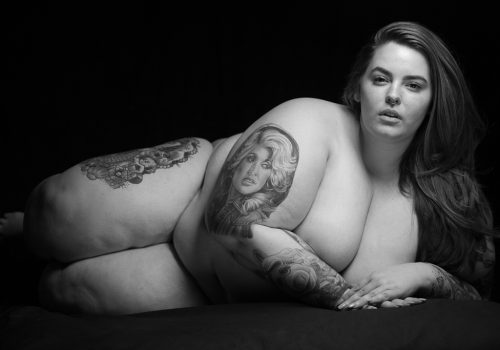The black and white figures that wait for you on the screens in the darkened room seem alive. They are old women and young women, tall and short, model perfect and people perfectly imperfect. Their images all are naked. They breathe softly while looking inward, and at the same time they are looking at you. This is genius work, a different way to see. The women, so alive in front of you, are gazing back as you gaze at them.
Scott Nathan spent the last four years asking his friends, some of them models, and celebrities, to sit and be present as themselves for ten minutes while he photographed them continuously. He shot mainly with RED digital cinema cameras and he often turned the camera 90 degrees on their side so the images he captured were vertical. The moving portraits he made are presented as black and white images on large monitors turned vertically as well.
The process he used was simple. When one of the subjects arrived at Scott’s apartment he gave them no direction per se. Instead he told them what he wanted was to know them better, not their public face, their facing the camera persona, but who they really were. Then he showed them into the space, his living room with only a piece of black cloth on the wall to make it a studio, and told them to take as much time as they wanted arranging and preparing themselves. When they were ready he came back in and lit them in their selected pose, then went down a hallway to where he had his monitor and focus controls. Then he turned on the camera and played music, Ascenseur pour l’echafaud, a beautiful album by Miles Davis, and he recorded his subjects for ten minutes as they sat in the improvised studio alone.
Scott is a well-known celebrity photographer so the light is polished and the images pristine. Just hearing about it you might think this sounds not unlike Bill Violas imagery but it’s not. What is new here is that the time observed is real time, the people slowed and magnified by their long slow passage in front of the camera doing “nothing.” The effect is not the same as the hypnotic ever so slow gaze of a high speed camera, the one that shows us microseconds of time. This camera sits passive, slowly recording ten minutes in the real existence of a person. We watch while they sit in their electronic windows, alone with their thoughts and feelings. But the gaze is not one way. The women look at the camera, they look directly into the lens and what is on the other side of the lens is … you. The effect is eerie. They come alive in a very powerful way, and not all of what happens is peaceful or beautiful.
Another forerunner of this work is Andy Warhol’s long unblinking films Sleep and Empire, but again this is different. In Confessional, the seemingly accidental passage of time in Warhol’s films is replaced by a compact between camera and person to be present no matter what feelings are stired up for ten intense minutes. The women blink, they breathe, they shift ever so slightly, and they laugh and they cry. Their experiences in front of the camera are not the usual controlled display of emotion but instead the emotions they stir up in themselves and then experience in front of the camera. Scott told me that at some point during the sessions many of the women felt such strong emotions they began to weep. We feel it too and that is the heart of the experience to me. When he showed some of these portraits to an early audience he watched them as one of his subjects laughed and saw that the audience laughed too, while in the next clip the subject cried and the audience cried as well. Thinking about it later Scott told me, “It seems the human brain doesn’t distinguish between a 2D image of a person crying and a real person sitting in front of them doing the same thing.”
The setting of the show plays a role in how we feel as well. Seen as part of Frieze Los Angeles, Nathan took over a large sound stage at RED Studios and left it completely unlit except for the light coming from the eight monitors and one projector. There were some tiny devotional candles scattered around, not for light but to help set the scene. The same Miles Davis piece the women had listened to provided the soundtrack and the people who had come to see moved slowly in the darkness stopping to commune with one face or another. The effect on the viewers was both spiritual and emotionally powerful.
All of this begs the question “Is this photography or a movie?” and I suspect there will be differences of opinion. To me it seems born from the instincts of photography rather than that of films. It offers an unblinking presentation of one single thing and gives you the opportunity to explore that thing for a long time. And in doing that it opens a door to a new way of thinking about the portrait and it does it well.
Scott Nathan
https://www.instagram.com/scottnathaneditions/
Andy Romanoff
















